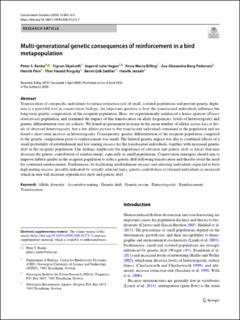| dc.description.abstract | Translocation of conspecific individuals to reduce extinction risk of small, isolated populations and prevent genetic depletion is a powerful tool in conservation biology. An important question is how the translocated individuals influence the long-term genetic composition of the recipient population. Here, we experimentally reinforced a house sparrow (Passer domesticus) population, and examined the impact of this translocation on allele frequencies, levels of heterozygosity and genetic differentiation over six cohorts. We found no permanent increase in the mean number of alleles across loci or levels of observed heterozygosity, but a few alleles private to the translocated individuals remained in the population and we found a short-term increase in heterozygosity. Consequently, genetic differentiation of the recipient population compared to the genetic composition prior to reinforcement was small. The limited genetic impact was due to combined effects of a small probability of establishment and low mating success for the translocated individuals, together with increased genetic drift in the recipient population. Our findings emphasize the importance of selection and genetic drift as forces that may decrease the genetic contribution of reinforcement, especially in small populations. Conservation managers should aim to improve habitat quality in the recipient population to reduce genetic drift following translocation and thereby avoid the need for continued reinforcement. Furthermore, by facilitating establishment success and selecting individuals expected to have high mating success, possibly indicated by sexually selected traits, genetic contribution of released individuals is increased which in turn will decrease reproductive skew and genetic drift. | en_US |

